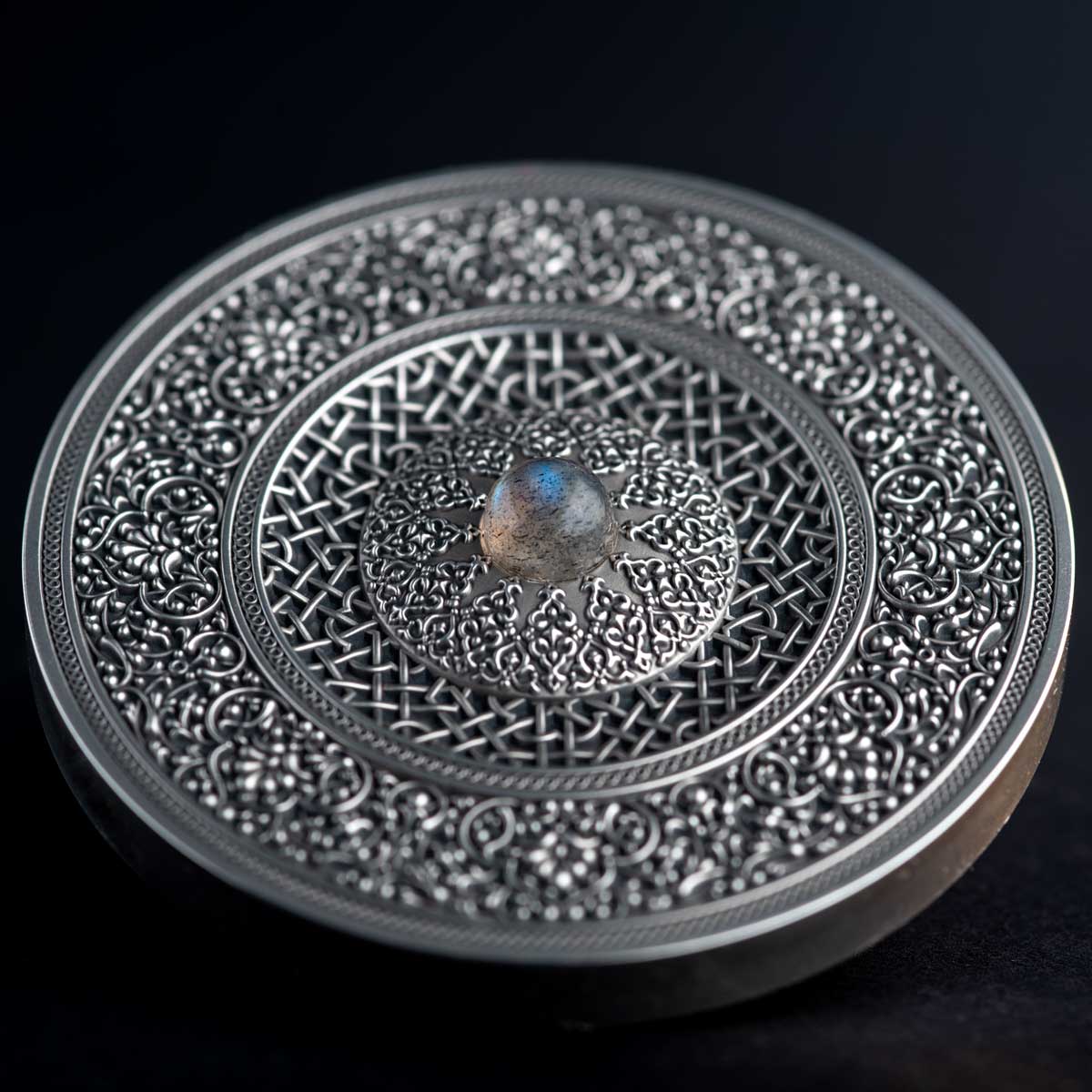Art Mint’s elegant ‘Mandala Art’ series returns for a seventh release with a striking Turkish inspired design
We’ve long admired Art Mint’s flagship ‘Mandala’ series of coins, and it’s been a pleasure to watch it grow in ambition and intricacy since it debuted in 2015. The last two issues in particular, the Gothic and the Persian, were beautiful examples of the numismatic art, and we’re pleased to say that the 2021 coin keeps up the high standard set by them.
The series hasn’t moved too far geographically, going from Persia to Turkey, and you can see the linked DNA between the two styles, but this one has leaned more towards a uniform level of detailed relief, rather than a mix of bold lines and a fine background that defined the Persian coin. It is another gorgeous piece of work, with the focal point being an almost ethereal looking piece of labradorite, a gemstone that exhibits an iridescent effect actually called labradorescence because of its distinctive nature.
The biggest change last year was the contouring of the reverse face. The centre area was domed upwards, with the piece of wide jasper inset at its peak. The 2021 coin continues the trend, but has the domed area set inside a deeply concave centre section. Despite all these changes in elevation, the fine geometric detail remains uninterrupted. It’s all very impressive.
Antique-finished, and with a three-ounce 0.999 silver composition, this remains a higher-end range of coins, but one that holds an almost timeless quality. Very nicely presented, the series remains a testament to the passion this French producer brings to its products. Available to order now, the mintage of 500 is not expected to hang around for long. We now have a full profile to the series up for those who want to see all the previous issues in one place and in high resolution.
WHAT IS A MANDALA?
The meaning of mandala comes from Sanskrit, meaning “circle.” It appears in the Rig Veda as the name of the sections of the work, but is also used in many other civilizations, religions and philosophies. Even though it may be dominated by squares or triangles, a mandala has a concentric structure. Mandalas offer balancing visual elements, symbolizing unity and harmony. The meanings of individual mandalas is usually different and unique to each mandala.
The mandala pattern is used in many traditions. In the Americas, Indians have created medicine wheels and sand mandalas. The circular Aztec calendar was both a timekeeping device and a religious expression of ancient Aztecs. In Asia, the Taoist “yin-yang” symbol represents opposition as well as interdependence. Tibetan mandalas are often highly intricate illustrations of religious significance that are used for meditation. From Buddhist stupas to Muslim mosques and Christian cathedrals, the principle of a structure built around a centre is a common theme in architecture.
In common use, mandala has become a generic term for any diagram, chart or geometric pattern that represents the cosmos metaphysically or symbolically; a microcosm of the universe. Representing the universe itself, a mandala is both the microcosm and the macrocosm, and we are all part of its intricate design. The mandala is more than an image seen with our eyes; it is an actual moment in time. It can be used as a vehicle to explore art, science, religion and life itself.
Carl Jung said that a mandala symbolizes “a safe refuge of inner reconciliation and wholeness.” It is “a synthesis of distinctive elements in a unified scheme representing the basic nature of existence.”
| SPECIFICATION | |
| DENOMINATION | $10 FJD (Fiji) |
| COMPOSITION | 0.999 silver |
| WEIGHT | 93.3 grams |
| DIMENSIONS | 50.0 mm |
| FINISH | Antique |
| MODIFICATIONS | Ultra high-relief, Labradorite stone insert |
| MINTAGE | 500 |
| BOX / C.O.A. | Yes / Yes |







Leave A Comment